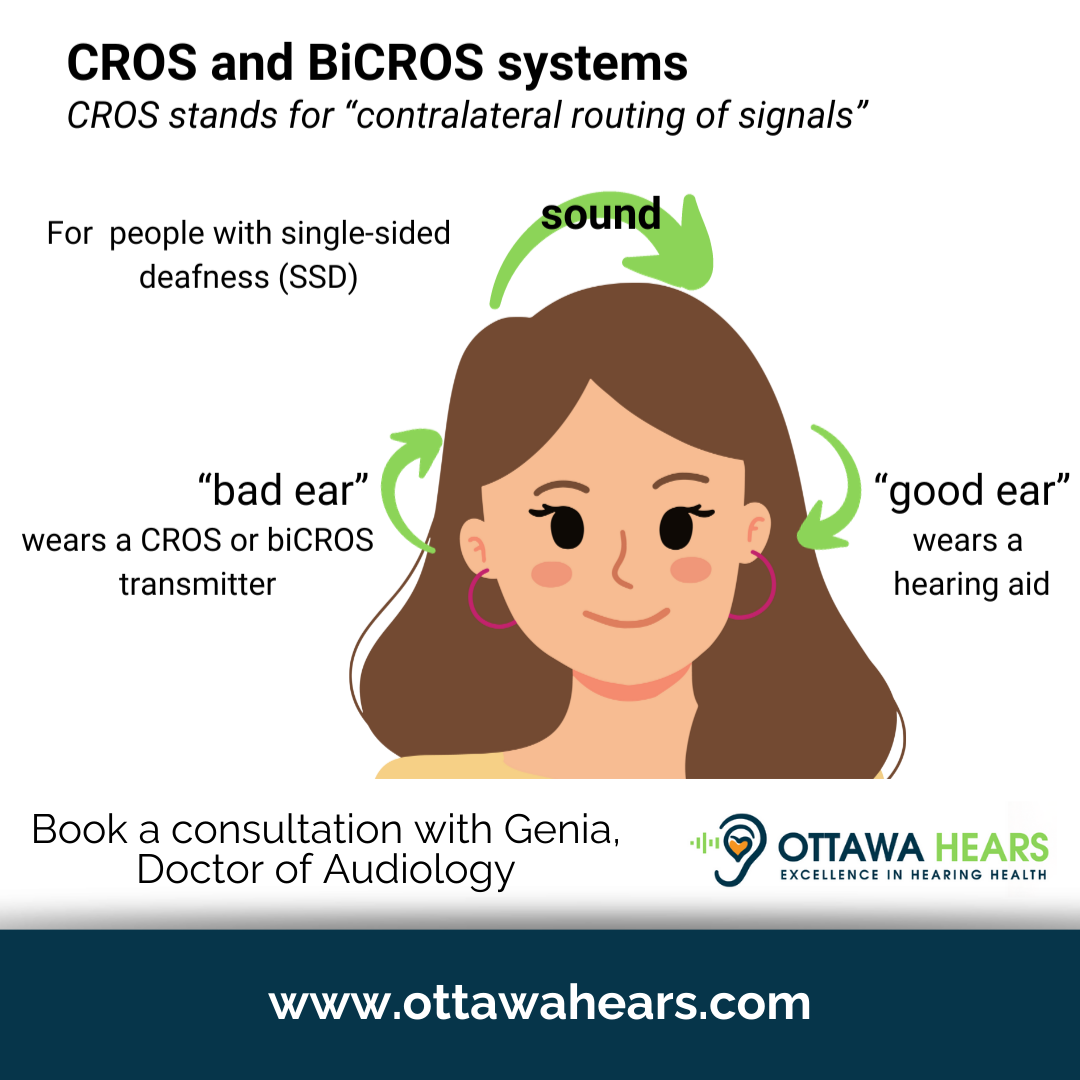CROS and BiCROS explained by Ottawa Hears

CROS (Contralateral Routing of Signal) and BiCROS (Bilateral Contralateral Routing of Signal) systems are beneficial for individuals with unilateral or asymmetric hearing loss. These systems function by transmitting sound from the impaired side to the better ear, thereby improving speech intelligibility and overall auditory perception.
A study by Choi et al. (2019) compared wireless CROS/BiCROS with soft-band Bone-Anchored Hearing Aids (BAHA) for patients with unilateral hearing loss. The findings revealed that CROS/BiCROS aids were superior in reducing the head shadow effect but had a negative impact when noise was introduced to the better ear (Choi et al., 2019).
Williams, McArdle, and Chisolm (2012) conducted research on new BiCROS technology in a veteran sample and found that 95% of participants reported improvements with the new BiCROS system, suggesting its efficacy compared to previous systems used by these individuals (Williams et al., 2012).
Oeding and Valente (2013) assessed a BiCROS system with a directional microphone and noted no significant differences in certain listening conditions, but a marked advantage was observed in a diffuse listening condition. This study highlighted the influence of microphone technology on BiCROS systems' performance in various acoustic environments (Oeding & Valente, 2013).
Another study by Choi et al. (2019) on the effectiveness of current wireless CROS technology in experienced bone-anchored implant users showed no significant difference between systems in aided benefit or overall performance across different listening configurations, underscoring the importance of personalized treatment planning in audiological rehabilitation (Choi et al., 2019).
Lastly, Mosnier et al. (2019) evaluated a wireless CROS device combined with a cochlear implant processor, which significantly improved speech intelligibility in noise. This demonstrates the potential benefits of CROS systems in challenging listening environments (Mosnier et al., 2019).
Overall, these studies collectively suggest that CROS and BiCROS systems can significantly benefit individuals with unilateral or asymmetric hearing loss, especially in terms of speech perception and hearing experience. However, the effectiveness of these systems can vary based on individual factors and specific listening environments, making personalized assessment and fitting crucial for optimal outcomes.
At Ottawa Hears Audiology, we provide top-quality audiological care to ensure the best hearing health outcomes for our patients.
🌐 Online: For more information or to book an appointment, please visit www.ottawahears.com. Our user-friendly online form is designed for your convenience.
📞 Phone: Prefer speaking to a person? Call us at 343-800-5909. Our friendly team is ready to assist you and answer any queries you may have.
Note: No medical referral is required to see our knowledgeable, experienced, certified, and regulated Audiologist. Additionally, many of our services are eligible for partial or full coverage by insurance or third-party payers.
References
Choi, J. E., Ma, S. M., Park, H., Cho, Y. S., Hong, S. H., & Moon, I. J. (2019). A comparison between wireless CROS/BiCROS and soft-band BAHA for patients with unilateral hearing loss. PLoS One, 14(2), e0212503. https://doi.org/10.1371/journal.pone.0212503
Williams, V. A., McArdle, R. A., & Chisolm, T. H. (2012). Subjective and objective outcomes from new BiCROS technology in a veteran sample. Journal of the American Academy of Audiology, 23(10), 789-806. https://doi.org/10.3766/jaaa.23.10.5
Oeding, K., & Valente, M. (2013). Evaluation of a BICROS System with a Directional Microphone in the Receiver and Transmitter. Journal of the American Academy of Audiology, 24(10), 980-991. https://doi.org/10.3766/jaaa.24.10.9
Mosnier, I., Lahlou, G., Flament, J., Mathias, N., Ferrary, E., Sterkers, O., Bernardeschi, D., & Nguyen, Y. (2019). Evaluation of a wireless contralateral routing of signal (CROS) device with the Advanced Bionics Naída CI Q90 sound processor. European Archives of Oto-Rhino-Laryngology, 276(8), 2205-2213. https://doi.org/10.1007/s00405-019-05467-9
keywords: Doctor of Audiology, Hearing Loss, Tinnitus, Audiology, Audiologist, Hearing Aids, FM system, Cochlear Implants, Tinnitus, Ear Health, Deafness, Hearing Test, Sensorineural Hearing Loss, Conductive Hearing Loss, Mixed Hearing Loss, Noise-Induced Hearing Loss, Ear Infections, Hearing Loss Treatment, Hearing Loss Prevention, Audiologist Consultation, Hearing Loss in Seniors, Hearing Loss in Children, Assistive Listening Devices, Otology, Ear Anatomy, Hearing Rehabilitation, Hearing Loss Symptoms, Hearing Health, Ear Protection, Custom Earplugs, Ottawa Hears Audiology, Oticon, Phonak, Unitron, Widex, Signia, Resound, Starkey